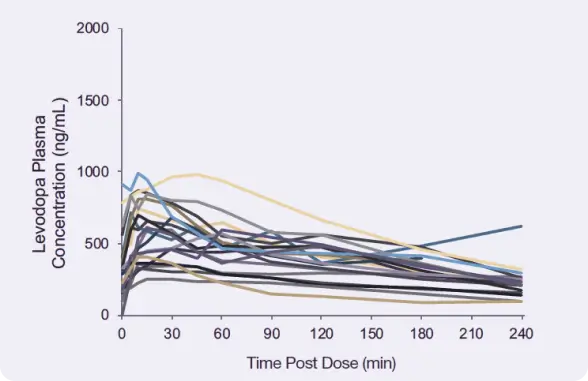INBRIJA® Indication
INBRIJA® (levodopa inhalation powder) is indicated for intermittent treatment of OFF episodes in patients with Parkinson’s disease (PD) treated with carbidopa/levodopa.
Important Safety Information
CONTRAINDICATIONS
- INBRIJA is contraindicated in patients taking or who have recently taken (within 2 weeks) nonselective monoamine oxidase (MAO) inhibitors (e.g., phenelzine and tranylcypromine) due to risk of hypertension.
WARNINGS AND PRECAUTIONS
- Patients treated with levodopa have reported falling asleep during activities of daily living, including operation of motor vehicles, which sometimes resulted in accidents. Many patients reported somnolence but some reported no warning signs (sleep attack). Some of these events were reported more than a year after initiating treatment. Reassess patients for drowsiness/sleepiness including occurrence during specific activities. Advise patients of potential for drowsiness and ask about factors that may increase this risk.
- Consider discontinuing INBRIJA in patients who report significant daytime sleepiness or falling asleep during activities that require active participation. If continuing INBRIJA, advise patients not to drive and to avoid activities that may result in harm. There is insufficient information that dose reduction will eliminate episodes of falling asleep during activities of daily living.
- Neuroleptic malignant syndrome-like symptoms (e.g., elevated temperature, muscular rigidity, altered consciousness, autonomic instability) have been reported with rapid dose reduction, withdrawal of, or changes in dopaminergic therapy.
- Hallucinations and abnormal thinking and behavior may occur. Because of the risk of exacerbating psychosis, patients with a major psychotic disorder should ordinarily not be treated with INBRIJA and dopamine antagonists used to treat psychoses may exacerbate PD symptoms and decrease the effectiveness of INBRIJA.
- Patients treated with INBRIJA can experience intense urges to gamble or spend money, increased sexual urges, binge eating, and/or other intense urges, and inability to control them. In some cases, these urges stopped with dose reduction or medication discontinuation.
- INBRIJA may cause or exacerbate dyskinesias. If troublesome dyskinesias occur, consider stopping INBRIJA or adjusting other PD medications.
- INBRIJA is not recommended in patients with asthma, COPD, or other chronic underlying lung disease because of the risk of bronchospasm.
- Monitor patients with glaucoma for increased intraocular pressure.
- Abnormalities in laboratory tests may include elevations of liver function tests (e.g., alkaline phosphatase, AST, ALT, lactic dehydrogenase, bilirubin), blood urea nitrogen, hemolytic anemia, and positive direct antibody test. Increased levels of catecholamines and their metabolites in plasma and urine may result in false-positive results suggesting pheochromocytoma.
ADVERSE REACTIONS
The most common adverse reactions (≥ 5% and higher than placebo) were cough (15% vs 2%), upper respiratory tract infection (6% vs 3%), nausea (5% vs 3%), and sputum discolored (5% vs 0%).
DRUG INTERACTIONS
Use of selective MAO-B inhibitors with INBRIJA may be associated with orthostatic hypotension. Monitor patients taking these drugs concurrently. Dopamine D2 receptor antagonists (e.g., phenothiazines, butyrophenones, risperidone, metoclopramide) and isoniazid may reduce levodopa efficacy; monitor patients for worsening PD symptoms. Iron salts or multivitamins with iron salts may reduce levodopa bioavailability.
USE IN PREGNANCY AND LACTATION
There are no adequate data on the developmental risk associated with INBRIJA in pregnant women or on the effects on breastfed infants. Animal data shows carbidopa/levodopa is developmentally toxic (including teratogenicity). Levodopa may interfere with lactation. Levodopa has been detected in human milk.
PEDIATRIC USE
Safety and effectiveness in pediatric patients have not been established.
GERIATRIC USE
Patients 65 years of age and older (n=56) experienced more of the following adverse reactions than patients <65 (n=58): cough (25% vs 5%), upper respiratory tract infection (11% vs 2%), nausea (7% vs 3%), vomiting (4% vs 2%), pain in extremities (4% vs 0%), and discolored nasal discharge (4% vs 0%).
Visit www.inbrija-hcp.com to obtain the Full Prescribing Information, Patient Information and Instructions for Use.


.webp)





 Please see Full Prescibing
Please see Full Prescibing